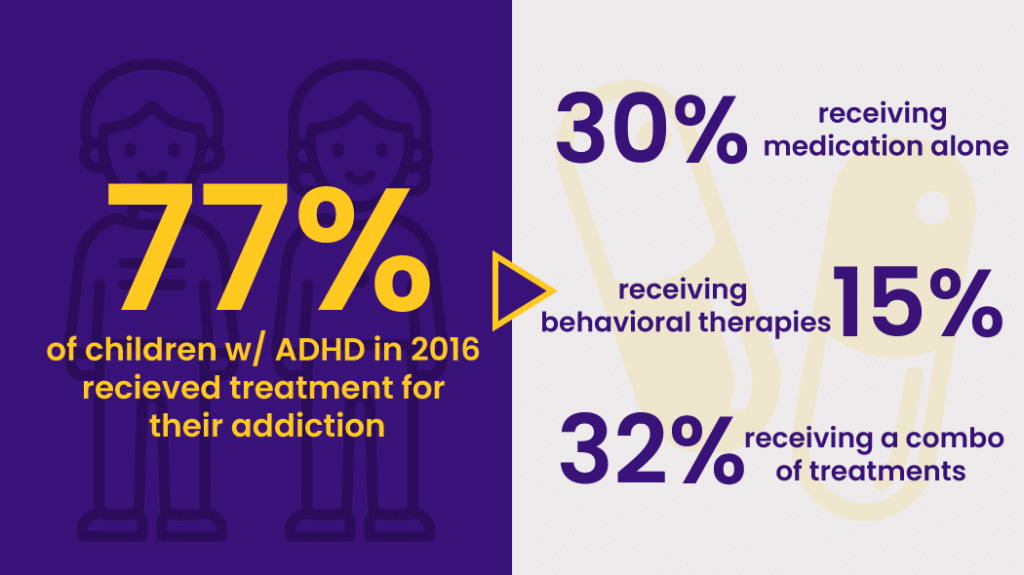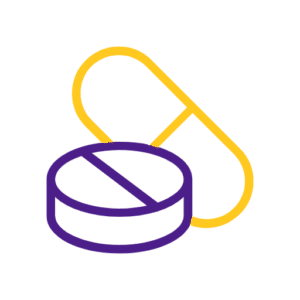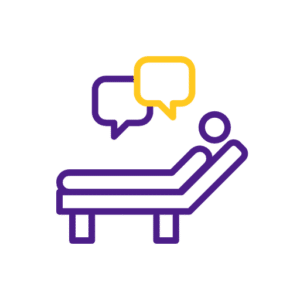Individuals with ADHD tend to be overly active, have trouble concentrating, and become bored easily. Oftentimes, people who suffer from ADHD are more likely to develop a substance abuse disorder to cope with the symptoms of ADHD. These disorders combined commonly provoke a cycle of addiction that can be difficult to break without serious treatment.

ADHD and Addiction
Individuals with ADHD tend to be overly active, have trouble concentrating, and become bored easily. Oftentimes, people who suffer from ADHD are more likely to develop a substance abuse disorder to cope with the symptoms of ADHD. These disorders combined commonly provoke a cycle of addiction that can be difficult to break without serious treatment.
Table of Contents
Attention deficit hyperactivity disorder (ADHD) is a neurological condition that impacts a person’s ability to concentrate, sit still, and handle tedious tasks or boredom. Although ADHD is often diagnosed in children, about one-third to one-half of ADHD patients will experience symptoms as they grow older.1 ADHD often goes undiagnosed in adults, especially those who have another mental health condition.2
If you are an adult with ADHD, you may be more likely to experience substance abuse. ADHD patients often turn to drugs and alcohol to cope with the symptoms they experience or become addicted to stimulants they receive to treat their condition. Co-occurring ADHD and substance abuse can create a cycle of addiction that can be difficult to break without professional treatment.
Facts and Figures About ADHD
- 52% of children with ADHD had a behavioral or conduct issue
- 33% experienced anxiety
- 17% had symptoms of depression
- 14% had autism spectrum disorder
These issues can carry well into adulthood. While there is no cure for ADHD, symptom management is possible. Approximately 77% of children with ADHD in 2016 received treatment for their condition, with 30% receiving medication alone, 15% receiving behavioral therapies, and 32% receiving a combination of treatments.

Causes of ADHD
No one knows the exact cause of ADHD. However, there are certain risk factors that may increase a person’s risk of developing the condition.
Family History
Exposure to Lead
Tobacco Use During Pregnancy
ADHD Signs and Symptoms
- Being distracted
- Difficulty organizing tasks and activities
- Failing to pay close attention to details
- Difficulty staying focused during activities
- Difficulty following directions
- Avoiding tasks that require sustained mental focus
- Forgetting to do daily activities
- Fidgeting, tapping, and squirming
- Difficulty staying seated
- Talking too often
- Being in constant motion
- Difficulty accomplishing an activity quietly
- Difficulty waiting for a turn to speak or participate in activities
- Interrupting or intruding on others’ conversations or activities
The Link Between ADHD and Addiction
School, Work, and Relationship Issues
If you have ADHD, you may experience issues at work or in school. You may be unable to focus on tasks, misplace items you need to complete an assignment, and feel chronically disorganized. You may forget social engagements, obligations, and important dates, leading to interpersonal conflicts.
As a result, ADHD symptoms can strain your relationships and cause issues in your personal and professional life. These aggravating factors can cause ADHD patients to turn to drugs and alcohol to cope with their symptoms.
Dopamine Deficiency
ADHD patients have lower levels of dopamine in their brains, a neurotransmitter responsible for controlling pleasure, focus, and motivation. 10 When you take drugs or drink alcohol, a rush of dopamine enters your nervous system, triggering your brain’s reward system. Many adults with ADHD may abuse substances to make up for their dopamine deficiency, relying on larger amounts of the drug or alcohol to feel the same euphoric effects.
Stimulant Prescriptions
Many medications used to treat ADHD are stimulants, such as Adderall or Ritalin. Stimulants can cause feelings of alertness, euphoria, and increased concentration, speeding up the messages between the brain and body.11
While these prescriptions are effective at managing symptoms of ADHD, stimulants have a high rate of misuse and you may develop an addiction to them. Because of the high rate of substance abuse among people with ADHD, doctors who prescribe stimulants need to carefully monitor patients closely to prevent misuse and dependence.
Co-Occurring ADHD and Addiction Treatment
If you have co-occurring ADHD and substance abuse, professional help is necessary to break the cycle of substance abuse. Entering a dual diagnosis program can help you receive targeted treatment for your ADHD and addiction, as well as any other co-occurring conditions. Treating both conditions at once is necessary to relieve your symptoms and develop healthier strategies to cope with underlying mental health issues.
Dual diagnosis programs are valuable for multiple reasons. They help you modify destructive behavioral patterns and thoughts that contribute to substance abuse, as well as control symptoms of ADHD through medication and behavior management. This treatment also helps build self-esteem and encourage motivation, easing the transition to a healthier, substance-free lifestyle.



If you experience ADHD symptoms and struggle with substance abuse, you are not alone. Thousands of people experience co-occurring ADHD and addiction, and professional treatment can relieve these symptoms and restore your quality of life. Visit a drug and alcohol rehabilitation center as soon as possible to discuss your options for treatment.
References
- Gentile, J. P., Atiq, R., & Gillig, P. M. (2006). Adult ADHD: Diagnosis, Differential Diagnosis, and Medication Management. Psychiatry (Edgmont (Pa. : Township)), 3(8), 25–30.
- Ginsberg, Y., Quintero, J., Anand, E., Casillas, M., & Upadhyaya, H. P. (2014). Underdiagnosis of attention-deficit/hyperactivity disorder in adult patients: a review of the literature. The primary care companion for CNS disorders, 16(3), PCC.13r01600. https://doi.org/10.4088/PCC.13r01600
- Danielson ML, Bitsko RH, Ghandour RM, Holbrook JR, Kogan MD, Blumberg SJ. Prevalence of Parent-Reported ADHD Diagnosis and Associated Treatment Among U.S. Children and Adolescents, 2016. J Clin Child Adolesc Psychol. 2018 Mar-Apr;47(2):199-212. doi: 10.1080/15374416.2017.1417860. Epub 2018 Jan 24. PMID: 29363986; PMCID: PMC5834391.
- Faraone SV, Doyle AE. Genetic influences on attention deficit hyperactivity disorder. Curr Psychiatry Rep. 2000 Apr;2(2):143-6. doi: 10.1007/s11920-000-0059-6. PMID: 11122947.
- Donzelli, G., Carducci, A., Llopis-Gonzalez, A., Verani, M., Llopis-Morales, A., Cioni, L., & Morales-Suárez-Varela, M. (2019). The Association between Lead and Attention-Deficit/Hyperactivity Disorder: A Systematic Review. International journal of environmental research and public health, 16(3), 382. https://doi.org/10.3390/ijerph16030382
- Knopik, V. S., Marceau, K., Bidwell, L. C., Palmer, R. H., Smith, T. F., Todorov, A., Evans, A. S., & Heath, A. C. (2016). Smoking during pregnancy and ADHD risk: A genetically informed, multiple-rater approach. American journal of medical genetics. Part B, Neuropsychiatric genetics : the official publication of the International Society of Psychiatric Genetics, 171(7), 971–981. https://doi.org/10.1002/ajmg.b.32421
- Quinn, P. O., & Madhoo, M. (2014). A review of attention-deficit/hyperactivity disorder in women and girls: uncovering this hidden diagnosis. The primary care companion for CNS disorders, 16(3), PCC.13r01596. https://doi.org/10.4088/PCC.13r01596
- Wilens TE, Martelon M, Joshi G, Bateman C, Fried R, Petty C, Biederman J. Does ADHD predict substance-use disorders? A 10-year follow-up study of young adults with ADHD. J Am Acad Child Adolesc Psychiatry. 2011 Jun;50(6):543-53. doi: 10.1016/j.jaac.2011.01.021. Epub 2011 Apr 22. PMID: 21621138; PMCID: PMC3104208.
- Ercan ES, Coşkunol H, Varan A, Toksöz K. Childhood attention deficit/hyperactivity disorder and alcohol dependence: a 1-year follow-up. Alcohol Alcohol. 2003 Jul-Aug;38(4):352-6. doi: 10.1093/alcalc/agg084. PMID: 12814903.
- Blum, K., Chen, A. L., Braverman, E. R., Comings, D. E., Chen, T. J., Arcuri, V., Blum, S. H., Downs, B. W., Waite, R. L., Notaro, A., Lubar, J., Williams, L., Prihoda, T. J., Palomo, T., & Oscar-Berman, M. (2008). Attention-deficit-hyperactivity disorder and reward deficiency syndrome. Neuropsychiatric disease and treatment, 4(5), 893–918. https://doi.org/10.2147/ndt.s2627
- Wilens, Timothy E., (2004). Impact of ADHD and Its Treatment
on Substance Abuse in Adults. http://www.izun.org.il/imageBank/articales/2004.pdf